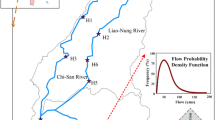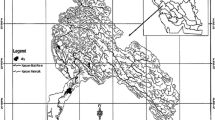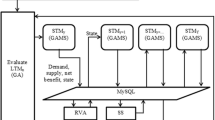Abstract
The presence of transient storage zone modifies the riverine pollutant transport. In the present work, new empirical expressions for three key parameters of transient storage model (TSM), an important method for predicting concentration variation of pollutants in rivers, have been derived employing genetic algorithm on published hydraulic data on river reaches and TSM parameters. The proposed expressions use few hydraulic and geometric characteristics of rivers that are usually available. Based on various performance indices, it can be concluded that the proposed expressions predict TSM parameters more reliably in comparison to the other empirical expressions for predicting TSM parameters.




Similar content being viewed by others
References
Ali H, Hossein MVS, Zeinab MVS (2011) GA-ILP method for optimization of water distribution networks. Water Resour Manage 25:1791–1808
Bansal MK (1971) Dispersion in natural streams. J Hydraul Div 97(11):1867–1886
Bencala KE, Walters RA (1983) Simulation of solute transport in a mountain pool-and-riffle stream. Water Resour Res 19(3):718–724
Cheong TS, Seo IW (2003a) Predicting parameters of transient storage zone model for riving mixing. Water Eng Res 4(2):69–85
Cheong TS, Seo IW (2003b) Parameter estimation of the transient storage model by a routing method for river mixing processes. Water Resour Res 39(4):1074–1084
Cheong TS, Younis BA, Seo IW (2007) Estimation of key parameters in model for solute transport in rivers and streams. Water Resour Manage ASCE 21(7):1165–1186
Czernuszenko W, Rowinski PM, Sukhodolov A (1998) Experimental and numerical validation of the dead-zone model for longitudinal dispersion in rivers. J Hydraul Res 36(2):269–280
Elder JW (1959) The dispersion of a marked fluid in turbulent shear flow. J Fluid Mech Cambridge UK 5(4):544–560
Fischer BH (1967) The mechanics of dispersion in natural streams. J Hydraulic Eng 93(6):187–216
Fischer HB (1968) Method for predicting dispersion coefficients in natural streams, with applications to lower reaches of the Green and Duwamish Rivers Washington. US Geological Survey Professional Paper 582-A
Godfrey RG, Frederick BJ (1970) Stream dispersion at selected sites. US Geological Survey Professional Paper 433-K
Goldberg DE (2001) Genetic algorithms. In: Search, optimization and machine learning. Addison-Wesley New York
Graf JB (1995) Measured and predicted velocity and longitudinal dispersion at steady and unsteady flow, Colorado River, Glen Canyon Dam to Lake Mead: water-resour bulletin. Am Water Resour Assoc 31(2):265–281
Hays JR, Krenkel PA, Schnelle KBJ (1967) Mass transport mechanisms in open-channel flow. Sanitary and water resour engineering department of civil engineering technical report 8. Van-derbilt University, Nashville, Tennessee
MathsWork (2004) The MathWorks, Inc., Natick, MA, USA
McQuivey RS, Keefer TN (1976) Convective model of longitudinal dispersion. J Hydraul Div 102(10):1409–1424
Nordin CF, Sabol GV (1974) Empirical data on longitudinal dispersion. US Geological Survey Water Resour Investigations 20–74, Washington, D C
Okubo A (1973) Effect of shoreline irregularities on streamwise dispersion in estuaries and other embayments. Neth J Sea Res 6(1):213–224
Pedersen FB (1977) Prediction of longitudinal dispersion in natural streams, Series Paper 14, Technical University of Denmark, Lyngby
Piotrowski AP, Rowinski PM and Napiorkowski JJ (2009) Estimation of parameters of models of pollutant transport in rivers depending on data availability.33rd IAHR Congress: Water Engineering for a Sustainable Environment, pp. 1179–1186
Rowiński PM, Piotrowski A (2008) Estimation of parameters of transient storage model by means of multi-layer perceptron neural networks. Hydrol Sci J 53(1):165–178
Runkel RL, Bencala KE, Broshears RE, Chopra SE (1996) Reactive solute transport in streams, 1, development of an equilibrium-based model. Water Resour Res 32(2):409–418
Seo IW, Cheong TS (2001) A moment-based calculation of parameters for the storage zone model for river dispersion. J Hydraulic Eng ASCE 127(6):453–465
Seo IW, Yu D (2000) Modeling solute transport in pool-and-riffle streams. Water Eng Res 1(3):171–185
Singh SK (2002) Discussion of “Moment-Based Calculation of Parameters for the Storage Zone Model for River Dispersion” by II Won Seo and Tae Sung Cheong. J Hydraulic Eng ASCE 128(11):1032–1033
Singh SK (2003) Treatment of stagnant zones in riverine advection-dispersion. J Hydraulic Eng ASCE 129(6):470–473
Singh SK (2008) Comparing three models for treatment of stagnant zones in riverine transport. J Irrig Drain Eng ASCE 134(6):853–856
Thackston EL, Schnelle KB (1970) Predicting effects of dead zones on stream mixing. J Sanit Eng Div 96(SA2):319–331
Worman A (2000) Comparison of models for transient storage of solutes in small streams. Water Resour Res 36(2):455–468
Acknowledgment
The suggestions for improving the language and the content of the paper from the unknown two reviewers are gratefully acknowledged by the author.
Author information
Authors and Affiliations
Corresponding author
Rights and permissions
About this article
Cite this article
Sahay, R.R. Predicting Transient Storage Model Parameters of Rivers by Genetic Algorithm. Water Resour Manage 26, 3667–3685 (2012). https://doi.org/10.1007/s11269-012-0092-3
Received:
Accepted:
Published:
Issue Date:
DOI: https://doi.org/10.1007/s11269-012-0092-3




